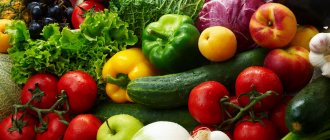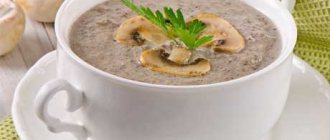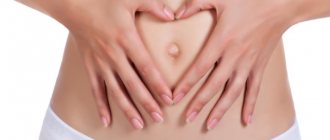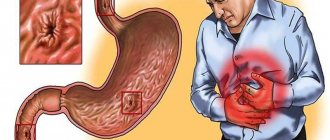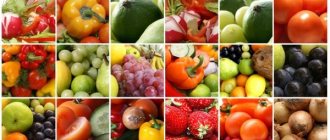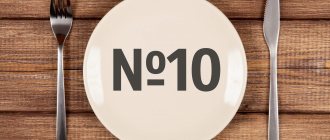Proper diet for flatulence and bloating in adults
The purpose of therapeutic nutrition is to combat increased gas formation and its causes, which are fermentative and putrefactive diarrhea.
Properly organized dietary nutrition:
- Normalizes the motor function of the gastrointestinal tract;
- Reduces inflammatory processes;
- Fights rotting and fermentation in the lower digestive tract;
- Provides the patient with complete, perfectly balanced nutrition;
- Restores normal intestinal microflora.
The diet prescribed in cases of flatulence corresponds to treatment table N5, however, taking into account the physiological characteristics of the patient and the presence of other gastrointestinal problems, a sample menu is compiled individually.
Therapeutic nutrition for flatulence and bloating has a lower energy value compared to the norm - up to 1600 kcal, of which:
- Protein – up to 120 grams;
- Fat – up to 50 grams;
- Carbohydrates – about 200 grams.
In addition, the consumption of monosaccharides is limited.
Content
- Symptoms of bloating
- Diet features
- List of prohibited products
- Diet rules for bloating
Bloating with flatulence or constipation occurs at any age and causes a person discomfort and severe pain. The cause of this unpleasant phenomenon may be overeating, stress, gastritis, pancreatitis or eating fatty foods. A diet for bloating helps get rid of severe gas formation, eliminates symptoms and pain. It is necessary to adhere to it regularly, supplemented by walks and light exercise.
What can you eat
The list of products allowed for consumption by people suffering from flatulence includes mainly those that:
- They have a carminative effect;
- Restrains the formation of gases.
The main difference between dishes prepared from these products is that they do not linger in the intestines. Their slow, gentle movement throughout the digestive tract promotes easy and painless passage of gases and normalization of the bowel movement process.
Since fermentative and putrefactive bacteria actively multiply during flatulence, the intestinal microflora undergoes significant changes. In order to inhibit the growth of pathogenic bacteria and create conditions under which normal microorganisms will actively develop, the patient needs to eat the right foods:
- Dried (“yesterday’s”) bread;
- Wheat crackers;
- Weak chicken or fish broth;
- Steamed and baked dishes from lean poultry meat (turkey or chicken) - cutlets, meatballs, meatballs, meatballs, galantine, soufflé and others;
- Boiled sea fish (cooked whole or cutlets from it, fish croquettes are also allowed);
- Low-fat fermented milk products and dishes using them - pureed cottage cheese and a variety of cottage cheese casseroles, sour cream, curdled milk, fermented baked milk, biokefir;
- Eggs - mainly in the form of an omelet, steamed or soft-boiled;
- Boiled or baked vegetables - dishes from pumpkin, zucchini, potatoes, carrots, beets;
- Slimy porridges - semolina, rice (mashed), oatmeal and buckwheat (cooked in water and also pureed, since whole grains can cause bloating, flatulence and diarrhea).
In order to enrich your diet with vitamins and give food a pleasant taste and aroma, you need to include garden herbs - parsley and dill - in your daily menu, add spices to your dishes - bay leaf, cumin seeds.
As for drinks, there are no significant restrictions: the consumption of green tea, rosehip decoction, apple compote, strawberries, raspberries, blueberries and other seasonal fruits is allowed. Once a day you can drink a small cup of cocoa with skim milk.
What is strictly prohibited
Products, the use of which during flatulence is strictly prohibited, contribute to increased gas formation. They can be divided into several subgroups.
- The first subgroup contains everything that the patient’s body cannot normally absorb - as usual, these are dairy products (if the body does not produce enough lactase).
- The second includes coarse plant fiber - a food substrate for intestinal microflora, which enhances the growth and activation of the vital activity of pathogenic microorganisms that cause fermentation and gas formation.
- In the third group are simple carbohydrates, which are easily broken down in the digestive tract and cause the process of rotting of the food mass.
Currently reading: How to get rid of flatulence 100% at home quickly
To inhibit the proliferation of pathogenic bacteria and prevent the increased formation of gases in the intestines, you need to:
Temporarily remove from consumption dishes that contain large quantities of carbon dioxide and organic acids, which means they contribute to increased intestinal motility;
Reduce the consumption of meat products due to the presence of connective tissue in them (protein foods tend to linger in the digestive tract for a long time, resulting in increased fermentation);
Do not consume foods containing food additives, preservatives, organic acids, large amounts of salt and spices - all of this has an irritating effect on the digestive system.
During treatment you should avoid:
- Fresh (“today’s”) bread – both rye and wheat;
- Fresh baked goods - it is advisable to abstain from them altogether, but if it is very difficult to resist buying a bun or sweet pie, at least eat yesterday’s ones;
- Pasta, dumplings and dumplings;
- Fatty and stringy meat - pork, beef;
- “heavy” poultry meat – duck, goose, game;
- Sausages - the flavor enhancers, stabilizers and soy they contain cause very strong gas formation;
- Strong broths with a high content of extractives;
- Canned vegetables containing vinegar and spices – pickles and marinades;
- Any mushrooms – including oyster mushrooms and champignons;
- Animal fats - lard, butter, homemade village sour cream and cream;
- Various kinds of appetizers like caviar or salted fish;
- Certain types of cereals - pearl barley, millet, barley;
- Hard-boiled eggs and scrambled eggs - the favorite fried egg made in lard by many causes turmoil in the intestines and pain in the stomach;
- Some vegetables - beans, peas, lentils, beans, radishes, radishes, daikon, all types of cabbage, raw onions and dishes using it;
- Fruits with a sweet taste - pears, melons, peaches, some varieties of apples, grapes;
- Dried fruits – dried apples and pears, dried apricots, prunes, raisins;
- Any spices;
- Hot sauces - both industrially produced and homemade;
- Honey;
- Jam;
- Chocolate – sometimes you can eat one or two cubes, just choose bitter;
- Cocoa and coffee with whole milk;
- Fermented milk products with high fat content and distinct sourness.
All carbonated drinks, including mineral waters, are strictly prohibited. A glass of soda, drunk too hastily or on an empty stomach, can cause stomach turmoil, severe belching and flatulence, even in a person with a completely healthy intestine. It is also worth refraining from such drinks, in the preparation process of which yeast is used: beer, kvass, kumiss.
Menu (Power Mode)
If you are prone to flatulence, you need to eat food correctly: calmly, slowly, chew the food until it becomes pureed, opening your mouth only to put a new portion into it. Refrain from talking while eating (or at least don't drop words between two spoons) and give up the habit of washing down each bite with water or tea. This will help avoid accidental swallowing of air (a phenomenon called aerophagia), and the load on the digestive system will become noticeably less.
Currently reading: What foods cause flatulence and bloating in the intestines: list
Eat meals strictly by the hour. It's quite easy to adapt to this. In addition, by getting used to receiving “fuel” at certain hours, your digestive tract will work in accordance with a given regime: gastric juice, bile acids and pancreatic enzymes will be intensively produced only when you start eating. This will significantly reduce the likelihood of other, more dangerous, diseases of the gastrointestinal tract.
Are you used to chewing gum to freshen your breath and clean your teeth after eating? Alas, you will also have to give up this habit: while chewing, you can involuntarily swallow air, which will serve as a provoking factor for an attack of flatulence, and your stomach, deceived by the process of imaginary chewing, intensively produces juice in anticipation of the arrival of food, preparing the ground for the development of gastritis.
Follow your diet. It’s better to eat more often, literally every one and a half to two hours. Small portions of dietary dishes are digested and absorbed faster, and everything that the body could not process leaves the intestines in a timely manner without causing any pathological process.
Eat only warm food. By eating foods that are too hot—literally steaming—or too cold, you risk irritating your digestive tract. Hot tea, a spoonful of “fiery” borscht, as well as a hastily swallowed portion of ice cream, help increase the secretion of gastric juice and pancreatic enzymes, which irritate the intestines.
Follow cooking rules. Large pieces of fried meat are too harsh a test for the digestive tract. If you suffer from flatulence, prepare food differently: boil, bake in foil, simmer in a small amount of water or broth. The main thing is to avoid an abundance of fat and golden brown crust.
Follow the rules of product compatibility. For example, if you don’t want to suffer from bursting abdominal pain after breakfast, don’t drink a cucumber or an apple with milk, and don’t eat sweets and salty ones. Such combinations of products overload the digestive system, increase peristalsis and promote the fermentation process in the intestines.
Limit your salt intake. A level teaspoon per day is quite enough, and it is advisable to add some salt to an already prepared dish.
Drink plenty of fluids. One and a half to two liters of ordinary filtered water contribute to the timely evacuation of feces, due to which the fermentation process, inevitable in case of stagnation, cannot occur.
An approximate menu for a day with flatulence looks like this:
- First breakfast - pureed rice porridge, a glass of green tea with crackers.
- Second breakfast – mashed cottage cheese with a spoonful of sour cream (unsweetened).
- Lunch - a portion of vegetable soup, a piece of baked chicken breast with a side dish of mashed potatoes, vegetable salad, a slice of toasted bread, a compote of dried sour apples.
- Afternoon snack – strawberry jelly and two biscuits.
- Dinner – pureed buckwheat porridge, steamed chicken cutlet, boiled beetroot and carrot salad, a glass of rosehip decoction.
- At night (an hour before going to bed) – a glass of low-fat kefir with rye crackers.
Sample menu for the week
Making a menu on your own is quite difficult.
Experts have created a menu that can serve as a guide for creating your own diet:
| Day of the week | First breakfast | Lunch | Dinner | Afternoon snack | Dinner |
| Monday | Rice porrige | Green tea with biscuits | Mashed potatoes with chicken breast | Berry juice | Buckwheat with vegetables |
| Tuesday | Syrniki | Compote | Boiled veal with rice | Bird cherry decoction | Zucchini puree |
| Wednesday | Cottage cheese | Apple juice | Beef cutlets with buckwheat | Kissel | Potato casserole |
| Thursday | Semolina | Curdled milk | Vegetable soup | Rose hip decoction | Carrot soup |
| Friday | Unsweetened yogurt | Berry juice | Chicken broth, vegetable stew | Apple juice | Baked apples |
| Saturday | Fruit salad | Blueberry decoction | Boiled fish with baked potatoes | Green tea with biscuits | Cottage cheese casserole |
| Sunday | Syrniki | Rose hip decoction | Rice with chicken pieces and vegetables | Kefir | Grated carrot salad |
It is recommended to base the menu on vegetables, lean meat, and fish. Light soups, purees, and some fruit are acceptable. Berries and fruits are eaten only an hour after the main meal.
They are especially suitable for an afternoon snack, dinner, or before bed.
Folk remedies for flatulence
To free the intestines from gases and relieve abdominal pain, it is recommended to take decoctions of medicinal plants along with the diet, such as:
- Peppermint - pour one tablespoon of dry leaf into an enamel mug with a lid, pour 250 ml of boiling water, let it brew for half an hour, then strain and take a third of a glass 15 minutes before meals three times a day;
- Dill seed - pour a tablespoon of seeds with a glass of boiling water, cover tightly with a lid and leave in a warm place for at least three hours, then strain and take three spoons an hour before meals;
- Chamomile - brew a spoonful of dried flowers with a glass of boiling water, let it brew (at least two hours), strain and take one or two spoons twenty minutes before meals.
Currently reading: Causes of flatulence in children - quick help for the baby and reviews
Recommended drinks to reduce gas production
Even following a diet with increased gas formation in the intestines may not be enough, especially if flatulence is caused by serious disorders of the digestive organs. In such cases, nutritionists recommend including drinks in the diet that have a positive effect on the functioning of the organ, reduce flatulence, eliminate fermentation, and stagnation of feces.
In continuation of the chosen diet for gas formation in the intestines in adults, it is useful to regularly consume:
- Peppermint decoction. Grind the dry leaves of the herb, place the resulting gruel (15 g) in an enamel container, steam with boiling water (250 ml). Infuse the liquid for half an hour under the lid; to concentrate the beneficial elements, it is recommended to wrap the container in a warm towel. Strain and once completely cooled, place in the refrigerator. Use three times a day, recommended dosage is 70–80 ml.
- Drink made from chamomile flowers. Place the plant material (20 grams) into a brewing container and steam with boiled water (300 ml). Place in a water bath and simmer for a quarter of an hour under the lid. Remove, leave to cool, strain. Drink 100 ml three times a day. In a diet for flatulence, it is recommended to consume a liquid rich in useful elements before meals - while reducing the release of gas, the product will improve digestive processes.
- Dill decoction. A diet for bloating will be more effective if you regularly drink a drink made with dill seed. The home remedy promotes digestion, reduces flatulence, actively copes with prolonged constipation, and prevents fermentation in the intestines. To prepare the decoction, put the plant seeds (10 grams) in a brewing container, brew with boiling water (200 ml), leave to brew under the lid for half an hour. After straining, start taking it - consume 30–40 ml three times a day.
A rich drink made from rose hips is also recommended for use against flatulence and bloating. The product acts in several directions at once - it prevents the passage of gases, bloating, has a positive effect on digestion, and stabilizes the level of beneficial microflora in the intestines.
To prepare the drink you will need a tablespoon of ripe fruits of the bush. It is not recommended to grind plant materials - the fruits contain small, hard hairs; if strained incorrectly, there is a risk of causing irritation of the mucous membranes of the throat after drinking the drink. Pour water (300 ml) over the rose hips and place on the stove. Boil after boiling for 10 minutes, leave until cooled, strain. There are no restrictions on the consumption of the drink - drinking the tasty aromatic liquid is allowed up to three times a day. It is not prohibited to add sweet ingredients - honey, sugar. If you are worried about excess weight along with flatulence, you will have to give up sweets, otherwise there is a risk of weight gain and accumulation of fat deposits.
What happens if you don't follow a diet
When starting treatment for flatulence, you will have to be patient. Dietary foods do not look as appetizing as fried ones, with an abundance of fat and a beautiful golden crust, tickling the nostrils with the aroma of overseas spices. But they are very useful. By neglecting your diet, you risk facing a number of unpleasant and even dangerous consequences:
- Death of normal intestinal microflora;
- Activation of putrefactive and fermentative bacteria;
- The release of toxins is the result of bacterial activity;
- Intoxication of the whole body;
- Hypovitaminosis - the synthesis of some vitamins (for example, group B) is possible only when the intestines are inhabited by normal microflora.
By following a therapeutic diet, you will forever forget about flatulence and the discomfort associated with it - abdominal pain, loud rumbling and a distinct feeling of where the accumulated gases are moving through the intestines at that moment. Eat right - and you will be healthy!
Reviews
Dear readers, your opinion is very important to us - therefore, we will be glad to receive feedback on the diet for flatulence in the comments, this will also be useful to other users of the site.
Alevtina, Pskov
“Since childhood, I loved buckwheat porridge. The first dish I learned to cook was buckwheat - crumbly, boiled, delicious to look at, and so delicious! I used to pour hot milk from under our cow over it, eat it and praise it. My mother and grandmother praised me - both for my housekeeping and for the fact that I eat well; for me this was the greatest joy. I don’t remember that buckwheat caused any protest in my stomach in those years. But later, around the age of twenty, I used to suffer from bloating. The milk was unusual, store-bought. I tried it a couple of times and left it. I forgot about my favorite porridge for a long time... And recently I was visiting my relatives in the village and there, remembering my love for this dish, they gave me a full bowl of buckwheat and poured homemade milk over it. It’s a sin to refuse, and it’s incredibly delicious! I ate everything clean - and after fifteen minutes I feel my stomach is swollen and gases are bubbling. She jumped up from the table and rushed to the latrine. I barely managed to run. Everything I ate flew out, and I also suffered from gas until the evening. I don’t remember buckwheat anymore.”
Daniil, Murmansk
“I have suffered from flatulence for many years. As soon as you eat something wrong, your stomach swells like a drum, and gases pass poorly, until you massage it - there is no result. It’s especially difficult in the summer: how can you, for example, not eat a piece of watermelon or a ripe pear? And they most of all cause turmoil in the intestines. I found a solution for myself: I eat watermelons with stale rye bread, just like my grandmother did. It became much easier! There are significantly fewer gases, and they leave almost imperceptibly.”
Features of children's nutrition
The causes of flatulence in children differ from adults in the underdeveloped digestive system and lack of enzymes for complete digestion of food. Babies can swallow air when feeding and crying, an unsuitable nipple, or an incorrect position.
Premature transition to nutritional formulas and intolerance to their composition are difficult for the child’s intestines to tolerate. In older age, among the causes of flatulence are a large number of baked goods, sweets, irregular nutrition, helminth infection, stressful situations, and diseases of the digestive system.
To improve the passage of gases in infants, a diet is necessary for a nursing mother. Be sure to exclude rye bread, legume products, grapes, carbonated drinks, coffee, kvass, cabbage, and chocolate from the diet.
For older children, the recommendations are no different from adults. Parents need to ensure that the child eats according to his age. If you have any complaints about constant bloating or pain, you should contact your pediatrician.
A symptom such as flatulence is not very specific to one disease. Therefore, we do not recommend long-term treatment with diet alone. If after applying dietary restrictions there is no improvement within a week, then you need to conduct an examination and identify the true cause of bloating.
jktguru.ru
